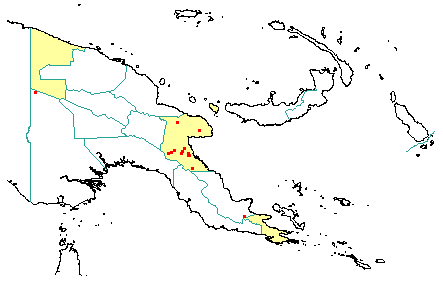
in PNGplants database
PNGTreesKey – Dryadodaphne crassa Schodde |
Barry Conn (NSW) & Kipiro Damas (LAE).
Guide to trees of Papua New Guinea
Copyright held by the authors, National Herbarium of New South Wales, and Papua New Guinea National Herbarium
Flora Malesiana, Series 1 Vol. 10: 265-267 (1986) Fig. 3.
Family: Atherospermataceae
Dicotyledon
Timber Group: Occasional timber species
Field Characters: Large canopy tree (20-35 m high); Bole cylindrical (mostly 45-60 cm diam., sometimes irregular in section); straight (bole 14-20 m long); buttresses buttresses present (buttresses up to 1.5 m high, often only slightly buttressed); spines spines absent; aerial roots aerial roots absent; stilt roots stilt roots absent; Bark grey or brown (or pale brown), slightly rough or smooth, pustular, lenticels elongated vertically; Subrhytidome (under-bark) yellowish green or yellow; less than 25 mm thick; bark blaze consisting of one layer; faintly to non-aromatic; pleasant; outer blaze yellow (pale (straw-coloured), with stripes, fibrous; inner blaze yellow (pale (straw-coloured), with stripes, fibrous; bark exudate (sap) present, colourless, not readily flowing (spotty), colour not changing on exposure to air, not sticky; terminal buds not enclosed by leaves.
Indumentum: Complex hairs absent; stinging hairs absent; mature twig indumentum (hairs) absent.
Leaves: Leaves spaced along branches, opposite (in pairs, opposite one another on the branchlet) (or sub-opposite), simple (a leaf composed of a single blade); petiole present, not winged, attached to base of leaf blade, not swollen; leaves slightly broadest above middle or broadest at or near middle, (3.0-) 4.5-8.0 (-10.0) cm, 1.0-3.0 (-4.5) cm; symmetric, entire or crenate (often obsurely so), not dissected or lobed, often emarginate or retuse or obtuse, venation pinnate, secondary veins open, not prominent, but visible, intramarginal veins absent; leaves lower surface pale green or green, upper surface dark green (glossy), indumentum (hairs) absent; absent; domatia absent; stipules absent.
Flowers: Inflorescence axillary, flowers on a branched axis, cones absent; flowers unisexual, unisexual with male and female flowers on the same plant, stalked, flowers with many planes of symmetry, 4.0-6.0 (-7.0) mm long, diameter small (up to10 mm diam.) (4-8 mm diam.); perianth present, with all sepals and/or petals (hence tepals) similar, inner perianth white, pale yellow, green (pale (yellowish green), or pale cream-coloured; 4 (inner and outer perianth whorls approximately equal in size), free or some or partly joined (by misinterpretation of hypanthium to be a perianth 'tube', such that separate perianth parts are incorrectly regarded as 'lobes' joined to form a perianth 'tube'); stamens 8, absent, free of each other, free of the perianth or joined to the perianth (perianth and stamens are joined to rim of hypanthium, but since hypanthium is perianth-like, the stamens may be incorrectly regarded as attached to the 'mouth' of the 'perianth tube'); ovary superior, carpels separate (when more than one), locules 15; styles free, 15.
Fruits: Infrutescence arranged on branched axis, fruit (3.0-) 5.0-6.0 mm long, 5.0 (c.) mm diam., brown, not spiny, non-fleshy (fruiting hypanthium thickened and hardened), aggregate, indehiscent or dehiscent (appearing to be dehiscent because hypanthium dehiscing into usually 4 valves, rarely opening into 2 valves), capsule (by misinterpretation), achene (densely covered with long erect hairs and terminal style); seeds 1 (per achene), to about 5 mm long (c. 3 mm long), not winged, narrow (longer than wide), seed 1-10 mm diam. (1-2 mm diam.).
Distribution: West Sepik, Morobe & Milne Bay.
 | Botanical records in PNGplants database |
Notes: Notes This genus was previously classified in the family Monimiaceae.